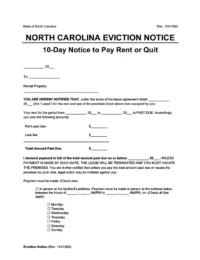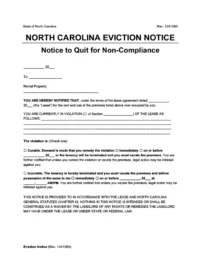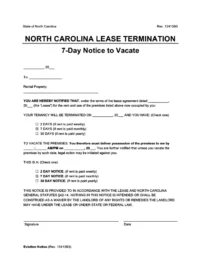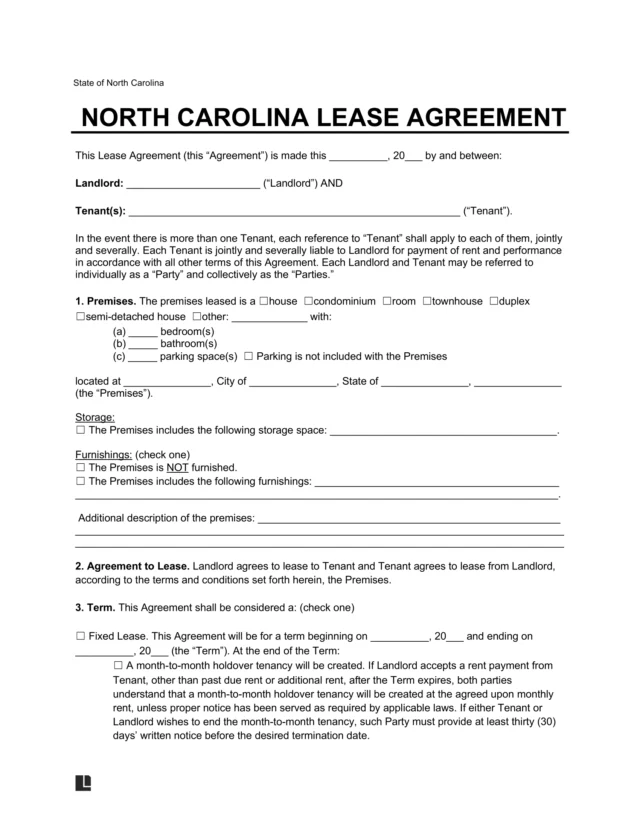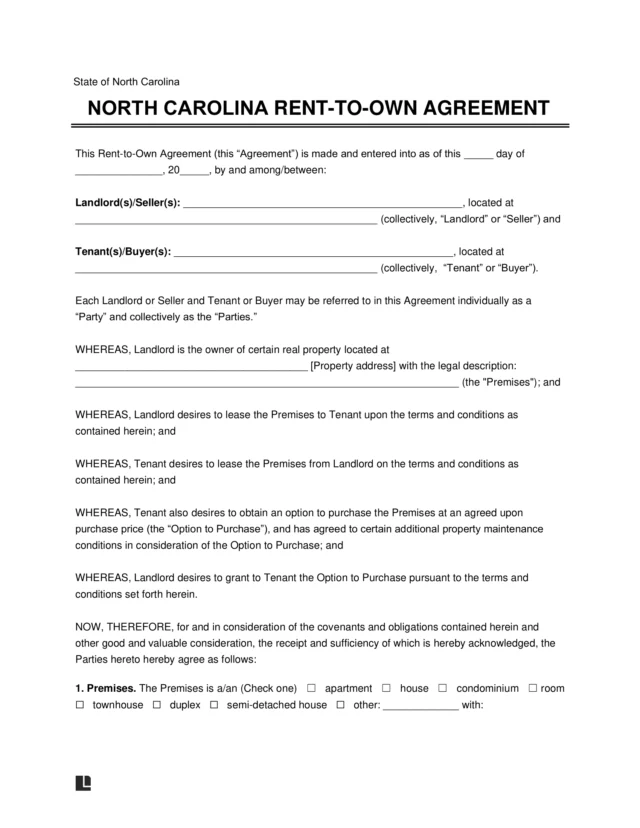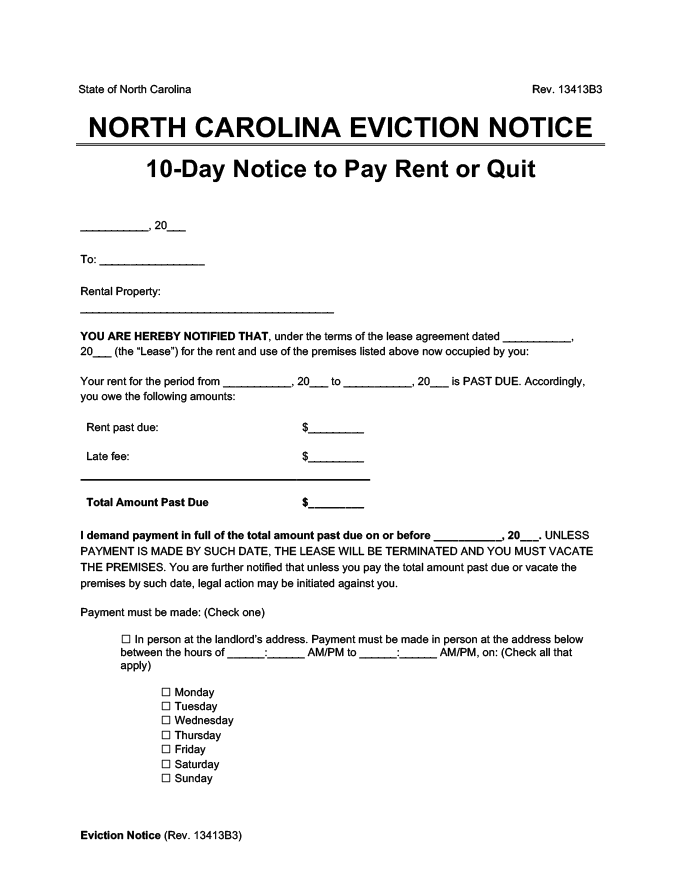Understanding Eviction Notices in North Carolina
North Carolina landlords must deliver a written notice to tenants before starting the eviction process. The notice depends on the reason, such as failing to pay rent, violating the lease, or ending the lease.
Create your North Carolina eviction notice with our step-by-step builder. Once finished, download it as a PDF or Word document.
Types of Eviction Notices in North Carolina
North Carolina has multiple notice forms, each associated with a different cause for eviction.
10-Day Notice to Pay Rent or Quit
Use this form to inform tenants that they must either pay overdue rent or vacate the property within ten days per § 42-3. This notice is served when rent is not paid, and according to § 42-46(a), tenants are given a five-day grace period to settle their rent before any interest charges are applicable.
If the tenant pays the full amount due, including any interest, within this timeframe, their tenancy is preserved. The notice must be in writing; verbal notices are not valid. Failure to comply with the notice within ten days empowers the landlord to initiate eviction proceedings.
10-Day Notice to Pay Rent or Quit
Evict a tenant if they haven’t paid rent on time.
Notice to Quit for Non-Compliance
This document lets you tell tenants if they breach the lease, detailing violations and how the tenant can fix them within a specific period. If tenants fail to comply, landlords may initiate eviction proceedings.
Unlike some notices that permit curing violations, it enables landlords to demand immediate tenant relocation for specific breaches per § 42-26(a)(2) and § 42-27. Grounds for immediate eviction include criminal activity, promoting criminal acts, and harboring or failing to report individuals barred from the premises, with no provision for tenants to rectify these violations.
Notice to Quit for Non-Compliance
Begin evicting a tenant if they’ve broken the terms of your lease.
2-Day Notice Lease Termination
Use this legal notice to inform week-to-week tenants of your intent to terminate the rental agreement. This notice requires tenants to vacate within two days per § 42-14 or risk facing an eviction lawsuit.
You are not obliged to state a reason for ending a weekly tenancy, provided it is not in retaliation or discrimination. This document enables you to swiftly end a week-to-week lease without a specific cause, setting a clear two-day deadline for tenant departure.
2-Day Notice Lease Termination
Let a tenant know that you’re ending a week-to-week lease and that they must prepare to leave your property.
7-Day Notice Lease Termination
Send this document to signal your intention to end a month-to-month rental agreement. It lets you give a week’s notice per § 42-14.
7-Day Notice Lease Termination
Let a tenant know that you’re ending a month-to-month lease and that they must prepare to leave your property.
30-Day Notice Lease Termination
Deliver this document to notify the tenant that you plan to terminate a year-long lease. Issue 30 days’ notice per § 42-14. This type of letter is particularly relevant for agreements that automatically renew yearly. It provides a structured and legally recognized method for ending the lease amicably and complying with North Carolina’s rental laws.
30-Day Notice Lease Termination
Let a tenant know that you’re ending a year-to-year lease.
How to Evict a Tenant in North Carolina
In North Carolina, eviction lawsuits are governed by Chapter 42, Article 3 of the North Carolina General Statutes. You must serve an eviction notice before filing a lawsuit against your tenant(s) to get your property back.
Step 1: Serve an Eviction Notice
To begin the eviction, you must first send your tenant the appropriate eviction notice. Under North Carolina law, you must notify the tenant that they’re being evicted and explain the reason for the eviction unless they’ve violated the lease agreement.
Step 2: File an Eviction Lawsuit With the Court
If the tenant refuses to move out of the property, file a Summary Ejectment with the North Carolina district or small claims court where the rental property is located.
Step 3: Attend the Court Hearing
After filing the case and paying the filing fee, your eviction court hearing will be processed and scheduled. A local court will issue a summons notifying the tenant of the hearing, which begins the legal proceedings for eviction. Both landlord and tenant must appear in court on the correct date. The case will be dismissed if the landlord doesn’t appear.
Step 4: Await Judgement
If the court rules in the landlord’s favor, a Judgment for Possession will be called the court. If the tenant fails to leave the premises after the judgment, the landlord may pursue a Writ of Possession. This will authorize the sheriff to remove the tenant forcibly.
Related North Carolina Court Forms
- Order for Eviction After Violation of Conditional Order of Eviction: This form documents either an eviction ruling in favor of the landlord or denies the tenant’s eviction. A magistrate signs it.
- Motion to Enforce Conditional Eviction Order Notice of Hearing: This form schedules a hearing to determine if the tenant must be forcibly removed from the rental property. It must be delivered to the tenant, notifying them of the court hearing date. It is signed by the Clerk of the Superior Court (CSC), Deputy CSC, or Assistant CSC.
- Complaint in Summary Ejectment: This document officially begins the eviction process and must be filed with the court by the landlord.
- Writ of Possession Real Property: This form declares that the tenant has been evicted and instructs the sheriff to remove them from the property. It is served on the tenant by the Deputy Sheriff.

